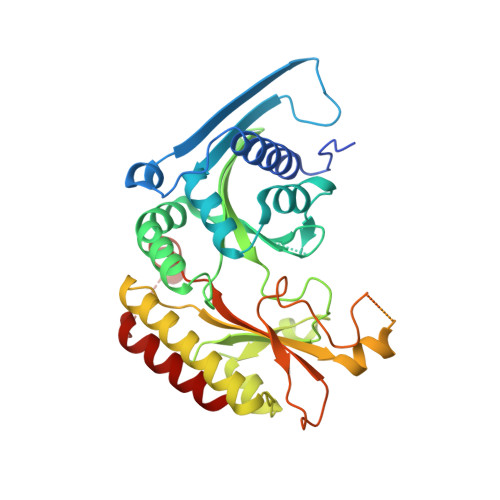Targeting the PI5P4K Lipid Kinase Family in Cancer Using Covalent Inhibitors.
Sivakumaren, S.C., Shim, H., Zhang, T., Ferguson, F.M., Lundquist, M.R., Browne, C.M., Seo, H.S., Paddock, M.N., Manz, T.D., Jiang, B., Hao, M.F., Krishnan, P., Wang, D.G., Yang, T.J., Kwiatkowski, N.P., Ficarro, S.B., Cunningham, J.M., Marto, J.A., Dhe-Paganon, S., Cantley, L.C., Gray, N.S.(2020) Cell Chem Biol 27: 525
- PubMed: 32130941
- DOI: https://doi.org/10.1016/j.chembiol.2020.02.003
- Primary Citation of Related Structures:
6OSP - PubMed Abstract:
The PI5P4Ks have been demonstrated to be important for cancer cell proliferation and other diseases. However, the therapeutic potential of targeting these kinases is understudied due to a lack of potent, specific small molecules available. Here, we present the discovery and characterization of a pan-PI5P4K inhibitor, THZ-P1-2, that covalently targets cysteines on a disordered loop in PI5P4Kα/β/γ. THZ-P1-2 demonstrates cellular on-target engagement with limited off-targets across the kinome. AML/ALL cell lines were sensitive to THZ-P1-2, consistent with PI5P4K's reported role in leukemogenesis. THZ-P1-2 causes autophagosome clearance defects and upregulation in TFEB nuclear localization and target genes, disrupting autophagy in a covalent-dependent manner and phenocopying the effects of PI5P4K genetic deletion. Our studies demonstrate that PI5P4Ks are tractable targets, with THZ-P1-2 as a useful tool to further interrogate the therapeutic potential of PI5P4K inhibition and inform drug discovery campaigns for these lipid kinases in cancer metabolism and other autophagy-dependent disorders.
- Department of Cancer Biology, Dana-Farber Cancer Institute, Boston, MA 02215, USA; Department of Biological Chemistry and Molecular Pharmacology, Harvard Medical School, Boston, MA 02115, USA.
Organizational Affiliation:


















